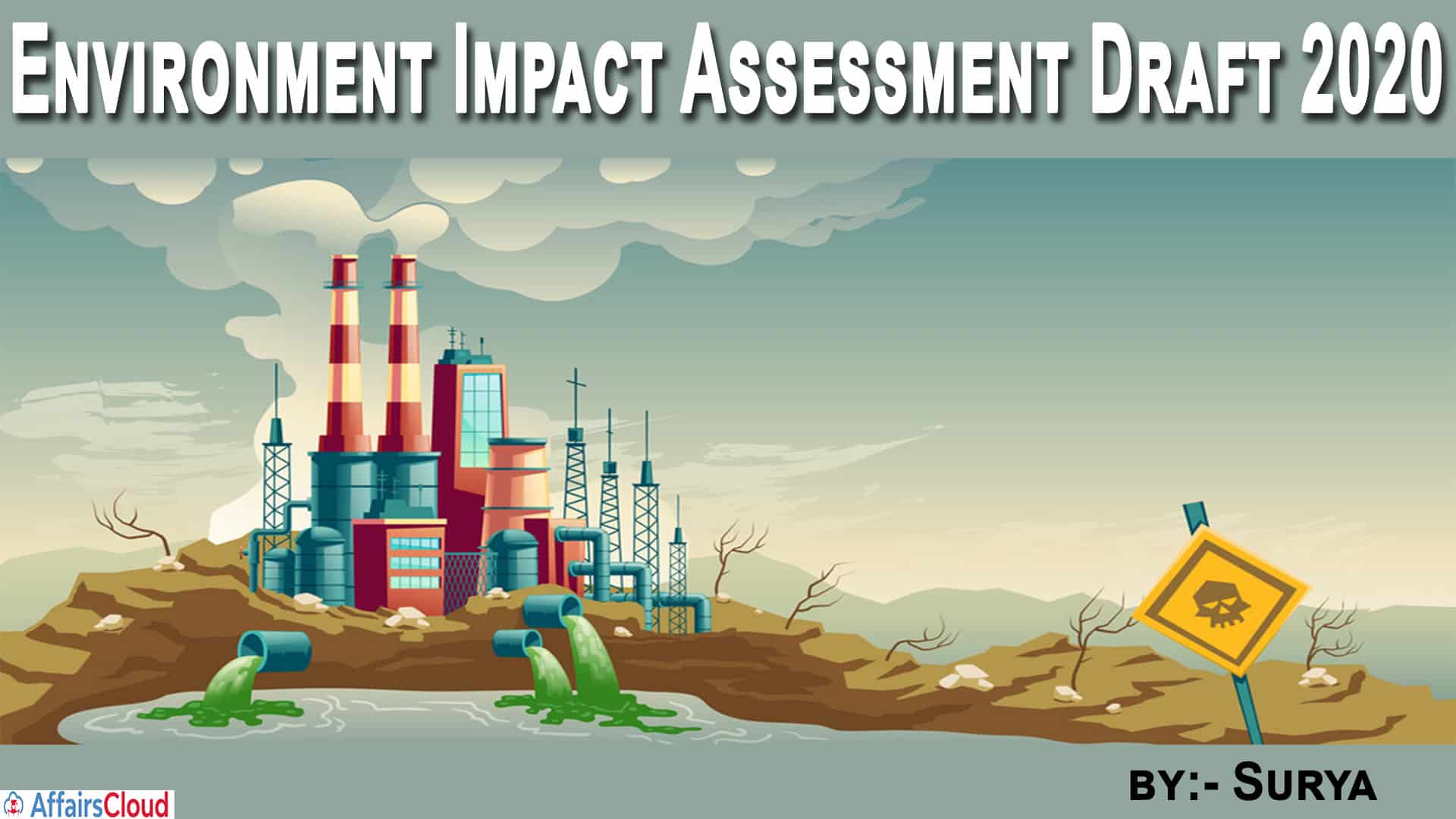Table of contents:
- Why in News?
- What is EIA?
- History of EIA in India
- EIA process
- 2020 Draft: Key Changes
- Post-Facto Clearance
Current Affair Overview:
- On 23rd March 2020, the Ministry of environment, forest and climate change (MoEFCC) had issued the Draft environmental impact assessment (EIA) notification 2020, which will replace the previous notification issued in 2006
- August 11, 2020 has been set as the deadline for receiving public comments regarding the draft.
What is Environmental Impact Assessment?
- It is the process or study which identifies the effects of a proposed industrial/infrastructural project on the environment.
- It prevents a proposed activity/project from being approved without proper impact assessment and attempts to compare various alternatives proposed for a project, preferring the alternative that best represents both economic and environmental interests.
- EIA is statutorily backed by the Environment Protection Act, 1986 which contains the framework for EIA methodology and process.
History of EIA in India –
- India is a signatory to Stockholm Declaration (1972) on environment, and subsequently enacted laws to control pollution in water (Water act of 1974) and air (Air act of 1981).
- Following the Bhopal gas tragedy in 1984, India legislated an umbrella act -The environment (protection) act of 1986
- In 1994, India set up a legal framework: The first EIA notification, under the Environment (Protection) act 1986 for regulating projects that access, utilise, affect the environment.
- The second EIA notification was legislated in 2006 which mandated obtaining environmental clearance for multiple categories of Projects/Industries.
Process of EIA:
-The assessment process is carried out by an Expert Appraisal Committee (EAC) which comprises of experts in environmental sciences and Project Management Experts.
Procedure:
- Scoping: The project’s potential impact on the environment, impact on nearby population is listed along with mitigation possibilities.
- Preparation of Initial EIA Draft: After Scoping the initial report is prepared listing out the baseline data gathered along with various alternatives available.
- Public Consultation: The initial EIA draft is then legally required to be presented to the concerned public for gathering their inputs. Concerned public meaning anyone that falls under the impact zone of the project.
- Preparation and Appraisal of final EIA Draft: After gathering and assessing the public input, the final EIA draft is prepared and goes through appraisal.
- Grant or rejection of Environmental Clearance: The Final EIA draft is then forwarded to the regulatory authority which in this case is the Ministry of environment, forests and climate change (MoEFCC). Ordinarily the ministry accepts the report sent by the Expert appraisal committee.
EIA draft 2020: Key changes
- The validity of environmental clearances for several category of projects has been increased.
For example: Mining Project clearance validity extended from 30 to 50 years.
- Proponents to submit compliance report once per year in contrast to every six months as it was the case with the 2006 notification
- Scope for Public complaints:
Violations to be reported either by a government authority or the developers themselves, Suo moto. There is no scope for any public complaint about violations. This is said to dilute the public participation principle of environmental law.
- Public Consultation process:
Time provided for the public to submit their responses has been reduced from 30 to 20 days.
Exemptions –
- All inland waterways projects, modernization of irrigation project and expansion/widening of national highways
- All offshore projects located beyond the 12 Nautical Miles
- Building construction projects of built-up area up to 1,50,000 sq. mts
- Roads and Pipelines in border areas:
All roads and pipelines in border areas, where border area is defined as – “Area within 100km Aerial distance from the line of actual control with neighbouring countries.” Shall be exempt from EIA. - Strategic projects:
No information shall be placed on the public domain for projects that are classified as “strategic”. The union govt shall have the authority to classify. Naturally projects concerning defence and security classified as strategic.
Post-Facto Clearance:
The 2020 EIA draft has proposed approval of Post-Facto clearance:
This means:
Projects that are operating without prior clearance/in violation of environment act can now apply for clearance.
- Provided that the violator presents two plans for remediation and augment resources corresponding to 1.5-2 times “the ecological damage assessed, and economic benefit derived due to violation”. This assessment shall be done the Expert appraisal committee.
- Also, Violator will need to pay Financial penalty of Rs 2,000-10,000 per day for the period of delay.
————————————————————————————————————————————
Write/Mail your inputs/Suggestions regarding the Environment Impact Assessment Draft 2020 to the Government –
Postal Address:
The Secretary, Ministry of Environment, Forest and Climate Change, Indira Paryavaran Bhawan, Jor Bagh Road, Aliganj, New Delhi110 003
E-Mail Address: [email protected].
———————————————————————————————————————————–





